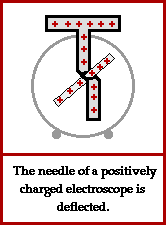
Grounding a
Positively-Charged Electroscope
A GIF Animation
An electroscope is a charge-detecting device which depicts the
presence of a charge on the apparatus itself or upon other objects in
the nearby vicinity. The presence of a charge on an electroscope is
depicted by the deflection of its needle from its usual upright
position. The needle, being free to rotate about its pivot, will be
deflected whenever the charge in the needle is the same as the charge
in the upright support upon which it balances. Since the
electroscope plate, support, and needle are connected and made of a
conducting material, any charge upon the electroscope will be
uniformly distributed about the entire conductor. Thus, if an
electroscope acquires an overall positive charge, this positive
charge will be spread about the entire electroscope - plate, support
and needle. Since like charges repel, the positively-charged support
and the positively-charged needle will repel each other, causing a
deflection of the needle.
 When the
positively-charged electroscope is touched, its charge becomes
grounded (or neutralized). This is depicted in the animation to the
right. The grounding process involves a transfer of electrons
between the charged electroscope and the conducting object to which
it is touched. When a positively-charged electroscope is touched,
electrons enter the electroscope from the ground. Being positively
charged, the electroscope attracts some electrons from the conducting
material (in this case, a person). The negatively-charged electrons
enter the electroscope and neutralize the positive charge. As the
electroscope loses its charge, the needle relaxes back to its
naturally upright position.
When the
positively-charged electroscope is touched, its charge becomes
grounded (or neutralized). This is depicted in the animation to the
right. The grounding process involves a transfer of electrons
between the charged electroscope and the conducting object to which
it is touched. When a positively-charged electroscope is touched,
electrons enter the electroscope from the ground. Being positively
charged, the electroscope attracts some electrons from the conducting
material (in this case, a person). The negatively-charged electrons
enter the electroscope and neutralize the positive charge. As the
electroscope loses its charge, the needle relaxes back to its
naturally upright position.
Additional information on physical descriptions of
electrostatic phenomenon will soon be available at
The
Physics Classroom.
This page was created by
Tom
Henderson of
Glenbrook South
High School.
Comments and suggestions can be sent by e-mail to
Tom
Henderson.
This page last updated on 2/9/98.
 When the
positively-charged electroscope is touched, its charge becomes
grounded (or neutralized). This is depicted in the animation to the
right. The grounding process involves a transfer of electrons
between the charged electroscope and the conducting object to which
it is touched. When a positively-charged electroscope is touched,
electrons enter the electroscope from the ground. Being positively
charged, the electroscope attracts some electrons from the conducting
material (in this case, a person). The negatively-charged electrons
enter the electroscope and neutralize the positive charge. As the
electroscope loses its charge, the needle relaxes back to its
naturally upright position.
When the
positively-charged electroscope is touched, its charge becomes
grounded (or neutralized). This is depicted in the animation to the
right. The grounding process involves a transfer of electrons
between the charged electroscope and the conducting object to which
it is touched. When a positively-charged electroscope is touched,
electrons enter the electroscope from the ground. Being positively
charged, the electroscope attracts some electrons from the conducting
material (in this case, a person). The negatively-charged electrons
enter the electroscope and neutralize the positive charge. As the
electroscope loses its charge, the needle relaxes back to its
naturally upright position.